Late-ripening cabbage hybrid Ankoma f1 for long-term storage
The cabbage hybrid Ankoma F1 combines ease of care, good yield and excellent taste of heads of cabbage. It is grown both on an industrial scale and in ordinary gardens. To obtain a rich harvest, it is important to follow some rules for growing crops, which are described in the article.
Description of the Ankoma cabbage hybrid
Ankoma is a mid-late hybrid of white cabbage. Was withdrawn Dutch specialists Rijk Zwaan company. Recommended for growing in open ground. Thanks to its many advantages and ability to adapt to different weather conditions, the hybrid quickly spread throughout the world.
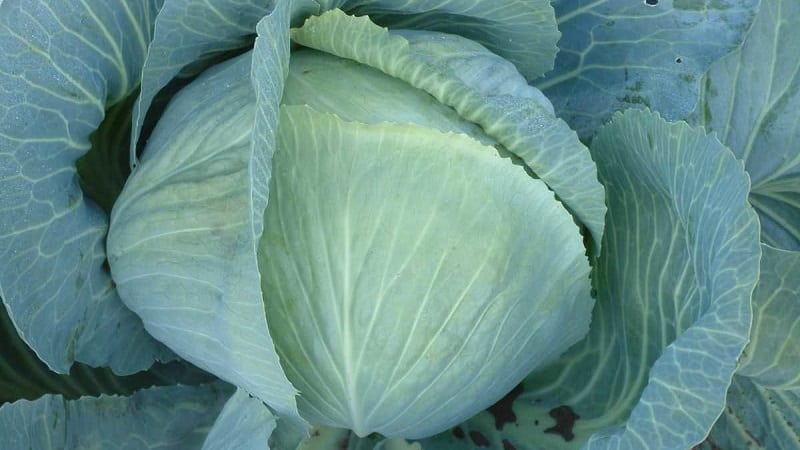
Ankoma F1 appeared in Russia in the late 90s. After successful testing, it was included in the State Register in 2007. Recommended regions for cultivation: North-Western, Central, North Caucasus, Middle Volga and West Siberian.
Chemical composition and beneficial properties
Cabbage - recognized dietary product: 100 g contains only 27 kcal. The vegetable contains a lot of fiber, which regulates the functioning of the gastrointestinal tract. Folic acid is involved in the synthesis of hemoglobin, phytosterols reduce the amount of cholesterol. Ascorbic acid, a powerful antioxidant, is involved in modulating immunity, the formation of collagen, and serotonin. Vitamins U and PP heal the gastric mucosa with small ulcers.
Cabbage is a source of vitamin K, which is responsible for blood coagulation.Vitamins B4 and B9 help normalize the metabolism of fats and carbohydrates, and beta-carotene maintains visual acuity.
Cabbage also contains a lot of minerals, especially potassium, silicon, manganese, boron, cobalt, and chromium.
Features of application
Ankoma cabbage is recommended for fresh consumption and long-term storage in a well-ventilated, cool room without bright lighting. Delicious heads of cabbage are stewed and used in the preparation of various dishes: pies, soups, preserves.
Ripening period
The hybrid heads reach technical ripeness after 120 days. from the moment of emergence.
Productivity
Each fork grows up to 3kg. The yield of the hybrid is 418–610 c/ha. The maximum value (714 c/ha) was recorded in the Smolensk region. The productivity of the crop is influenced by the number of sunny days during the growing season and soil fertility.
Resistance to disease and cold
Ankoma has strong immunity both the aboveground part and the root system. Resistant to many fungal diseases, including Fusarium wilt.
The hybrid is not afraid of short-term temperature drops to +5…+7°C, But long cold weather negatively affect the taste of the vegetable.
Characteristics of Ankoma cabbage
The hybrid has dense, obovate-shaped heads of cabbage.. The leaves are thin, gray-green, medium in size, with a slight wave along the edge, round in shape and lightly waxy. The leaf rosette is raised or vertical. The outer stump is long, the inner one is medium in size. The average weight of heads of cabbage is 2-3 kg; there are specimens weighing 4 kg.
At Ankoma crispy, dense texture, sweet taste. Tasting score: 4.4 points.
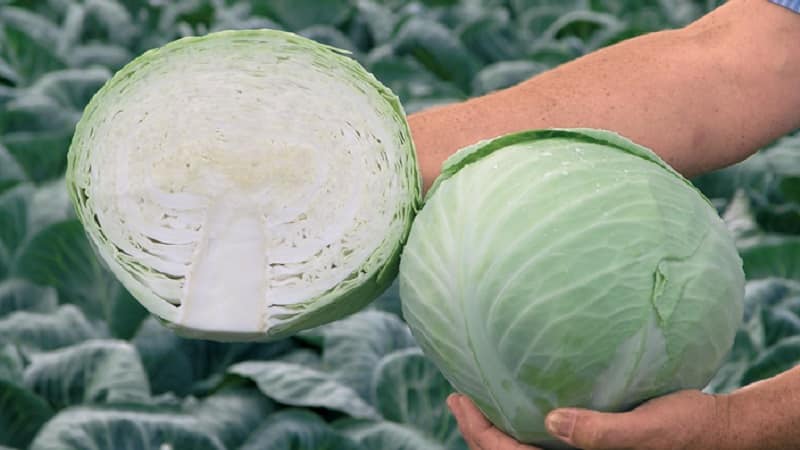
For which regions is it best suited?
Ankomu is grown in many regions of our country. The most common:
- Central;
- Middle Volga;
- West Siberian;
- North Caucasian;
- Northwestern.
For this hybrid frosts are undesirable during the period planting seedlings (in May the air temperature should be at least +15...+18°C, without sudden cold snaps at night) and drought. However, Ankoma is also grown in southern regions with dry summers. In this case, the crop does not suffer with regular watering.
Advantages and disadvantages
Among the main advantages of Ankom are::
- high and stable yield;
- good taste (sweetness, juiciness, no bitterness);
- frost resistance and adaptation to adverse weather conditions;
- storage duration: the harvest remains until the beginning of spring without loss of taste;
- transportability of heads of cabbage;
- immunity to fungal diseases;
- ease of care.
Explicit no deficiencies were identified during the variety testing.
Differences from other varieties and hybrids
This variety of cabbage recommended to grow seedling method. Her harvest ripens at the same time, the heads of cabbage are identical in shape and weight.
Features of planting and growing
For a rich harvest the selected area is prepared in the fall. It is dug up, weeds and large debris are removed, and fertilized with compost.
Reference. To grow cabbage, choose a well-lit area without shading. If Ankoma does not have enough light, it grows large leaves, which is why the heads of cabbage become loose, without proper juiciness.
Seed preparation
To strengthen future plants, seeds are hardened. To do this, they are immersed in hot water (+50°C) for half an hour, then lowered into cold water for 2-3 minutes. Then soaked in a solution of a growth stimulator.
The germination capacity of hybrid seeds is assessed as high (from 80%), but they are hardened not only to increase this indicator. The procedure improves the vitality of future seedlings.

Preparing seedlings
Selected seeds are planted in separate small containers 8–10 cm high, filled with loose nutritious soil. The ideal composition is a mixture of peat with a small addition of sand (2:1). It is allowed to use purchased universal primer.
The seeds are buried by 2-3 mm, sprinkled with a little soil, after which they are watered and covered with film, allowing the seedlings to “breathe” once a day. After 1-2 small leaves appear, the film is removed completely.
How to plant without seedlings
In the southern regions, in May, prepared seeds are sown immediately in open ground. A distance of 70–80 cm is maintained between them. At the initial stage of growth, the cabbage is covered with film. After the first shoots appear, the shelter is removed. Care for plants as usual.
Soil requirements
For Ankoma, choose loamy soil with a good nutritional composition and neutral or close to neutral acidity (pH 6.2–7.5).
Predecessors
Recommended for a good harvest plant Ankomu after legumes, nightshade and pumpkin crops. The hybrid cannot be planted after other types of cabbage, radishes and radishes.
Dates, scheme and rules of planting
Seedlings are prepared in early – mid-March and moved into open ground at the end of May - early June.
Advice! If there is groundwater in the area close to the surface, the beds are made at least 20 cm high.
The seedlings are placed in prepared holes and sprinkled with earth, slightly compacted, after which they are immediately watered.There is at least 70 cm between neighboring bushes so that the grown plants do not interfere with each other’s development. It is recommended to bury seedlings down to the first leaf. Repeated irrigation is carried out the next day. For better adaptation, the plants are lightly shaded with polyethylene for 2-3 days.
Features of cultivation
Young sprouts require careful care. They are protected from various manifestations of bad weather, for example, heavy rain or hail. To do this, the cabbage is covered with film, and when the precipitation ends, it is removed.
In the first 2-3 days after planting, the plants are watered with a weak solution of potassium permanganate, and the soil is sprinkled with wood ash for disinfection.
For a rich and tasty harvest perform basic agrotechnical techniques for caring for plants: they are regularly watered, loosened and hilled, fed, treated against pests.
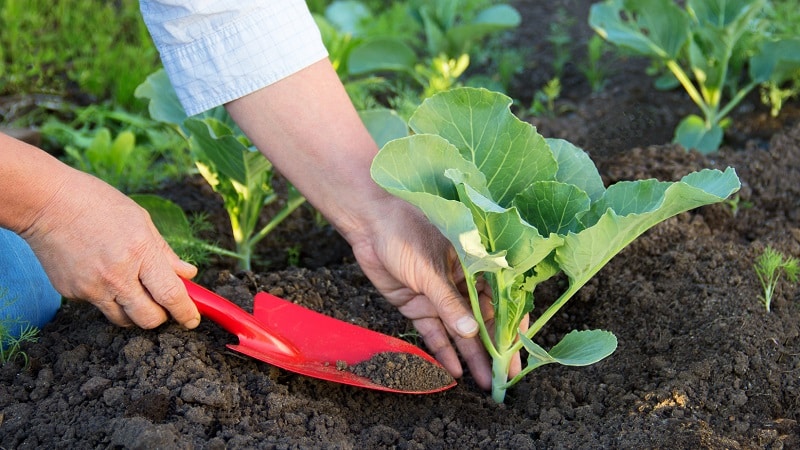
Watering mode
With a lack of moisture, the taste of cabbage deteriorates significantly, and the leaves become tough.. Therefore, regular watering is a prerequisite for obtaining a good harvest. It is carried out 3 times a week, morning and evening. Before the heads form, at least 1 liter of water is poured under each bush, after which the amount is gradually reduced.
Watering stops completely a month before harvest.
Loosening and hilling
The soil around the cabbage is loosened between each watering.so that the root system receives enough oxygen. Before this, debris is removed from the area and the plants are inspected, removing diseased or dried leaves.
The first hilling is carried out after the formation of several large sheets. This stimulates the development of new lateral roots. The second - after the appearance of the ovary, to strengthen the stem.Additionally, Ankoma hilling is carried out during prolonged rains to avoid stagnation of moisture, and if the stalk is exposed.
Feeding
Fertilize cabbage several times per season. For the first time, apply a weak aqueous solution of iodine tincture to young seedlings (3–5 drops per 1 liter of water). Once a month, use mullein infusion diluted with water (1:10).
For mineral fertilizers, use ammonium nitrate (20 g per 10 l of water) or urea (30 g per 10 l).
Measures to increase yield
The most high yields are obtained from seedlings grown in solar greenhouses, where it is very warm during the day and cool in the evening and at night. This hardens the sprouts, making them healthy and strong.
High-quality heads of cabbage obtained by following the planting scheme (70 cm between plants). Ankoma does not grow and is formed correctly, preserving the taste.
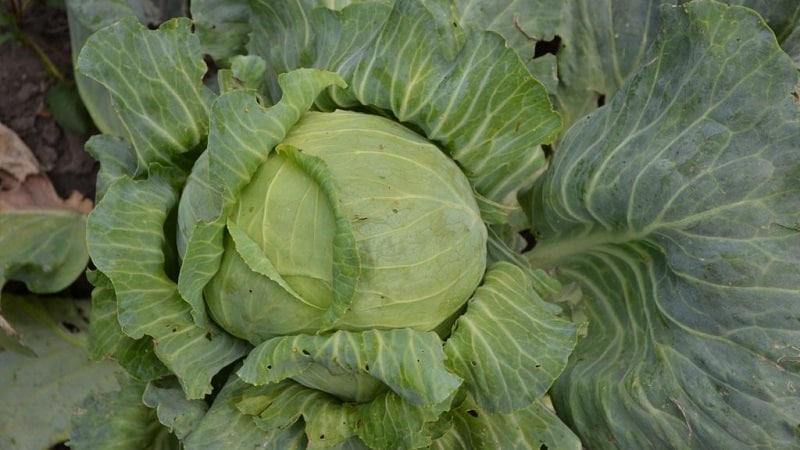
Disease and pest control
Although Ankoma has a strong immune system, you can’t take any risks. It is important to prevent diseases and pests. Young seedlings are treated with fungicides, for example, Fitosporin. If necessary, the procedure is repeated after 1–1.5 months.
Advice! To repel pests, experienced gardeners plant plants with a strong smell next to cabbage: spices, onions, garlic.
If the watering regime is violated, the crop suffers from black leg, downy mildew or rot.. In case of blackleg, the affected plants are removed from the soil. The soil is disinfected with a solution of potassium permanganate (1.5 g per 10 liters of water). In the future, the cabbage is regularly hilled, wood ash or river sand is added to the root. For downy mildew and rot, cabbage is treated with fungicides.
Of the pests for Ancoma, the cabbage fly is the most dangerous.. A solution of ammonia (5 ml per 10 l), which is used to treat each plant, will help get rid of it.
Possible difficulties during cultivation
With excessive watering, Ankoma suffers from black leg, downy mildew or rot. That's why it is important to observe the regularity and intensity of irrigationwithout flooding the plants and preventing moisture stagnation.
If shortly before harvest, when fungicide treatment is prohibited, cabbage is attacked by pests, use solution of fermented milk products. To do this, 1–1.5 liters of kefir are diluted in 10 liters of water, and the resulting mixture is sprayed onto the plants, paying special attention to the leaf rosette.
Harvest and storage
Harvest in dry September weather, 120–130 days after emergence, when the heads of cabbage have grown to their maximum size.
Storage features and shelf life of the hybrid
The density of the heads of cabbage allows them to be stored until the end of winter. To do this, the crop is placed in a dry, ventilated area. The temperature at the storage location should not fall below +5…+7°C.
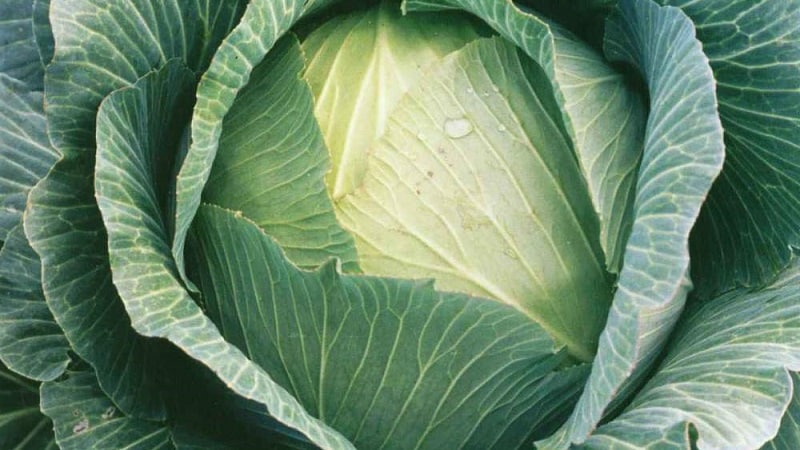
Tips and reviews from experienced gardeners
The hybrid is highly valued by gardeners due to its excellent taste and growing characteristics.
Tatyana Malova, Saratov: “I planted Ankoma for the first time last year. The germination of the seedlings is good, 9 out of 10 have taken root. The crop ripens evenly, the forks are the same size, 2–2.5 kg each. I was surprised by the keeping quality of the hybrid: the cabbage lasted until the end of winter without any problems.”.
Sergey Maslov, Krasnodar: “I grow Ankoma for sale. I don’t bother with seedlings, I sow the seeds right away. Cabbage grows quickly, and we harvest it in one fell swoop. Dense heads of cabbage tolerate transportation well, and their sweetness and juiciness are noted by all buyers.”.
Conclusion
Ankoma f1 is an unpretentious hybrid of white cabbage, suitable for cultivation in many regions of Russia. Among its features are ease of care, high productivity, and excellent taste of heads of cabbage. The crop has a strong immunity to fungal diseases and pests, but if it is over-watered, there is a risk of rot, downy mildew or blackleg.